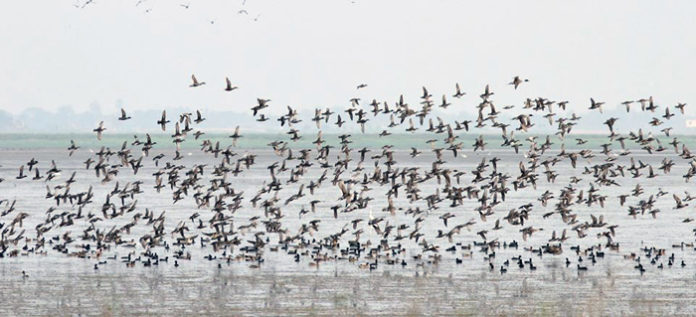By Rafiqul Islam
DHAKA, Jan 20, 2020 (BSS) – A huge number of winter birds flocked to Tanguar Haor this winter as the winged visitors found the overall environment better enjoyable at the prominent Asian wetland, which is rich in biodiversity.
A new survey, conducted by IUCN Bangladesh, counted 35 species of migratory birds with 51,368 individuals this time, while the figure was 32,225 in 2014, 17,204 in 2013 and 28,876 in 2012.
Out of the total 51,368 birds, the highest number was Common Coot with 9,925 individuals. Other birds included Red Crested Pochard (8,394), Common Teal (7,278), Pintail (5,000), Wegion (4,846), Glossy Ibis, Falcated Ducks and the endangered Pallas’s Fish.
The migratory birds species, which were seen in smaller numbers, were Great Cormorant, Little Cormorant, Black-tailed Godwit, Little Egret, Yellow-billed Egret, Grey Heron, Purple Heron, Indian Pond Heron, Black-crowned Night Heron, Northern Pintail, Tufted Duck, Common Moorhen, Phesentail Jacana, Black headed Gull, White Wagtail, Citrine Wagtail and Little Ringed Plover.
A team of the IUCN Bangladesh in association with Bangladesh Bird Club conducted the Water Bird Census in Tanguar Haor on January 19 this year under its Wildbird Monitoring Programme in Bangladesh.
Bangladesh Birds Club founder Enam Ul Haque was the head of the Census Team comprising IUCN researchers Sakib Ahmed and Zenin Azmiri and bird club members Paul Thompson and James Pender.
Tanguar Haor is a unique wetland of global importance and a Ramsar Site. Under leadership of the Ministry of Environment, Forest and Climate Change, IUCN Bangladesh has a long history of managing this important ecosystem, establishing community-based management and biodiversity conservation since 2006.
IUCN principal bird investigator Sarowar Alam Dipu said the IUCN is implementing the programme on Wildbird monitoring with support of Linnaues University.
Tanguar Haor is one of the key sites for implementation of some major activities, which include bird census, bird ringing and satellite tagging for long distance migratory birds study, he said.
As a part of this programme, IUCN Wildbird monitoring team along with Bangladesh Forest Department and Bangladesh Bird Club volunteers has started a 10-day bird research and monitoring camp in Tanguar Haor.
“Wild bird ringing and tagging are underway as well. Waterbirds were ringed, with species like Common Pochard and Tufted Ducks being ringed for the first time in Bangladesh. Lastly and most importantly, Gadwall has been tagged with a GSM/GPS satellite tag,” Dipu said.
He said the research plays an important role in understanding migration routes, wetland connectivity and overall conservation of wild ducks.
The IUCN bird investigator said safe habitats encourage the migratory birds to visit the wetlands of the haor this time as the environmental quality of the wetland was improved through proper management.
Noting that about 50,000 to 60,000 winter birds are counted in the Tanguar Haor in each January, he predicted that around two lakh birds will flock the haor in February this year as the water level of the wetland will be shallow during the month.
The waterfowl censuses in Tanguar Haor (1992-2012) shows that nearly 2.75 lakh migratory birds visited the haor in 2004 while 2.4 lakh in 2002, 2.1 lakh in 2003 and 1.9 lakh in 2005. The influx of birds has marked a drastic fall since 2005 while it was only 25,000 in 2007.
The Tanguar Haor is a unique destination for migratory birds, especially ducks. A large number of these birds use the aquatic vegetation for shelter, food and nesting.
At the onset of winter, the Siberian birds spread their wings to take flight of thousands of kilometres all the way from Siberia. The migratory maps show that they start their journey from Siberia, travel through Afghanistan and Central Asia before arriving at the famed bird sanctuaries of Bangladesh and India. These birds travel to a number of wetlands, including Hakaluki and Tanguar hoars.



